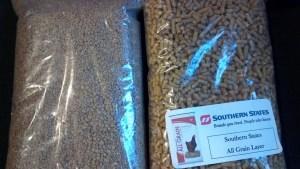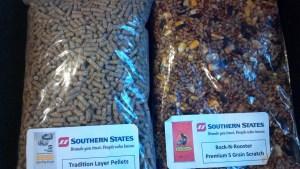Boy we’re having odd weather here in New Hampshire today. High winds last night and now it’s 58 degrees outside, in January. Weird.
Anyway, regardless of the weather, the calendar marches onward. Today is the last day of January (remember to say “rabbit, rabbit” tomorrow) and you know what that means, right?
Spring is coming and with Spring come the chicks!
New Hampshire has changed some of its agriculture laws – previously if you wanted to buy chicks from a feed store you had to buy them in quantities of at least 12. Not so anymore. Now there is no minimum purchase number. If I want to go into a store and buy just one chick, I can. (and I just might)
This means that there could potentially be a lot more small backyard flocks popping up around town.
So, in preparation, I thought now would be a good time to go through different feed options.
I received a few grain samples from the good folks at Southern States who had a booth at the Northeastern Poultry Congress.

From left to right.
Medicated chick starter – see how it’s finely ground? You want to give those babies something that’s easy for them to quickly get into their bodies. This particular bag of grain is medicated – the only time I use medicated feed is for the 5 or 6 weeks when my birds are chicks. I do this as a precaution. Birds that travel in groups (feed stores) or who live in other flocks are exposed to different germs. I don’t want those germs in my flock. Also, if a chick is exposed to a germ and then comes down with something, medicated feed gives them a bit more of a chance to fight it than not medicated. (I swear that a chick who ended up bringing home an illness survived because we were able to quickly get medicated feed into her.)
Once my chicks move outside into the henhouse though, that’s the end of the medicated feed. No antibiotic laced eggs for us, thank you very much.
As a note, they do make unmedicated chick feed if you want that option.
All Grain Layer – this is a vegetarian grain intended for laying birds. Interesting. If you tell me that you are using a vegetarian grain because you question the integrity of the meat supply in the US (they had another beef recall just the other day) then I might respect your decision. However, if you tell me that you are putting your birds on a vegetarian diet because you’re a vegetarian or that you think that ethically, it’s the right thing to do, then I suggest you do a little reading.
Chickens are omnivores. They like themselves a little bit of meat every now and then.

Which is why I also picked up a sample of the Tradition Layer Pellets which includes meat in the formula. This is the option I would use to feed my adult hens.
Lastly – take a look at the “Rock-N-Rooster Premium 5 Grain Scratch” it’s filled with high fat yummy seeds and corn. While I wouldn’t give this to my birds on a daily basis, a few scoops every week during the dead of winter (and even though it’s not cold today, we’ve had our freezing days) would be a wonderful addition to a flock’s diet.
During the winter we tend to throw a seed block into the coop every few weeks to give the flock some added nutrients, this feed would certainly be a good substitution to those blocks.
You might have noticed that I bypassed crumbles. We learned a few years back to move our chicks directly from chick feed to pellets. Chicks are pretty clever and can figure out how to break up the pellets very quickly. Crumbles just resulted in a large amount of wasted food as they waded through the feed and spread it all over the place.
***
Wendy Thomas writes about the lessons learned while raising children and chickens in New Hampshire. Contact her at [email protected]

